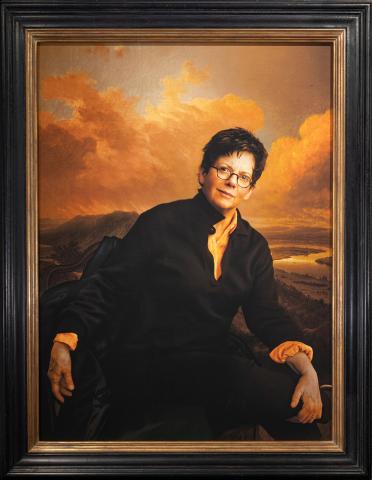There was a great gasp. Then a cacophony of claps and cheers. Then a standing ovation.
So went the reaction when the new portrait of President Emerita Biddy Martin was unveiled on Dec. 9, on a cold winter’s evening, at Johnson Chapel. It was a first among firsts: the portrait depicts the College’s first woman president, its first LGBTQ president and the first to break the chapel’s two-century-long painted portrait tradition.
Instead of a painting, it was a photograph, taken by the renowned photographer Annie Leibovitz, who has spent the past 50-plus years chronicling celebrities and newsmakers, and who has been designated a Living Legend by the U.S. Library of Congress.
Andrew J. Nussbaum ’85, chair of Amherst’s Board of Trustees, noted the incongruity of having a Leibovitz work in this space, joking that, no question, the person who took “the photo of Yoko Ono and a nude John Lennon should be represented in Johnson Chapel.” He added that if students had an SAT question on who belongs in a category that lists the Obamas, Lady Gaga, Serena Williams and Biddy Martin, it might be easy to guess the outlier.
Leibovitz also spoke that evening, chronicling her process with Martin. It all began at the 2019 commencement when the College gave Leibovitz an honorary degree. “We were on the podium during the commencement ceremony, and I said I wanted to photograph her,” recounted Leibovitz. “Seriously, I almost never do that.”

Portrait by Annie Leibovitz; click the photo for a larger version.
A few years later, Leibovitz and Martin met for several photo sessions. Leibovitz said she’d always had the idea of featuring a landscape in the background, but later decided to capture an image of a landscape painting, not photograph a scene herself. She found inspiration in The Oxbow of the Connecticut River, a painting in Martin’s office. Leibovitz added that, with the other portraits in the Chapel overwhelmingly depicting male subjects, Martin’s portrait had to make a statement. “If you are going to be here for all eternity, you have to hold your ground,” she said of Martin and the work.
Martin’s successor, President Michael A. Elliott ’92, spoke about Martin’s stamp on the College, in particular how she gave new, inclusive context to the Johnson Chapel portraits done before hers, presiding over the addition of the first portraits of women (Rose Olver and Emily Dickinson) and moving the portraits of Charles Hamilton Houston and William Henry Hastie to the more prominent, front-facing east wall.
“One of the things that impresses me so much in Biddy’s presidency was how she thought about how to bring her whole authentic self,” said Elliott. “To represent her as person in this space seems so meaningful. The way she will continue to inhabit Johnson Chapel will astonish and delight you.”
The crowd included longtime friends and family of Martin and some of her fellow college presidents, Paula Johnson of Wellesley and Maud Mandel of Williams. Martin got a laugh when she gently ribbed the latter: “Maud came all the way from Williams and that’s a trek.”
In Martin’s remarks she spoke about the honor for her, personally, to be in a portrait created by Leibovitz, and the honor for the College as well. “Perhaps an even greater gift, for me, was the opportunity to spend two days with Annie Leibovitz and her team,” she added. “Annie is such an extraordinary human being. She sees things at the level of detail, but also at a much broader, deeper conceptual level unsee-able by the rest of us, at least certainly by me. After each shot, she would change something. This is magical for someone who is not an artist. Being able to witness the process has been one of most incredible things of my life.”
After the ceremony, members of the audience drew near to the portrait and shared their reactions. Ron Bashford, associate professor of theater and dance, noted that its orange palette and darkening sky were similar to the two portraits of Emily Dickinson. Julie D’Acci, a friend of Martin’s from graduate school, said this of the portrait: “It’s absolutely magnificent. I've known Biddy for 40 years. I know her well, and I think it captures so many subtleties of her personality.”
Then Sonya Clark, the Winifred L. Arms Professor in the Arts and Humanities and professor of art and the history of art, put forth her insights. Martin “is thinking and looking towards the future” in the portrait, said Clark. “Which is to say, she is encountering the gaze of whoever is looking at the work, the students here and whoever encounters this work in the future. That’s a beautiful thing.”